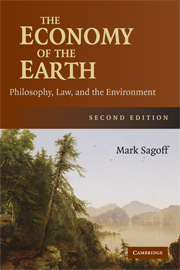Book contents
- Frontmatter
- Contents
- Acknowledgments
- 1 Introduction
- 2 At the Shrine of Our Lady of Fatima or Why Political Questions Are Not All Economic
- 3 The Allocation and Distribution of Resources
- 4 Values and Preferences
- 5 Can We Put a Price on Nature's Services?
- 6 Do We Consume Too Much?
- 7 Is an Environmental Ethic Compatible with Biological Science?
- 8 Settling America or the Concept of Place in Environmental Ethics
- 9 Natural and National History
- 10 Environmentalism: Death and Resurrection
- Notes
- Index
3 - The Allocation and Distribution of Resources
Published online by Cambridge University Press: 05 June 2012
- Frontmatter
- Contents
- Acknowledgments
- 1 Introduction
- 2 At the Shrine of Our Lady of Fatima or Why Political Questions Are Not All Economic
- 3 The Allocation and Distribution of Resources
- 4 Values and Preferences
- 5 Can We Put a Price on Nature's Services?
- 6 Do We Consume Too Much?
- 7 Is an Environmental Ethic Compatible with Biological Science?
- 8 Settling America or the Concept of Place in Environmental Ethics
- 9 Natural and National History
- 10 Environmentalism: Death and Resurrection
- Notes
- Index
Summary
In a course I teach on environmental ethics, I ask students to read the opinion of the Supreme Court in Sierra Club v. Morton. This case involves an environmentalist challenge to a decision by the U.S. Forest Service to lease the Mineral King Valley, a quasi-wilderness area in the middle of Sequoia National Park, to Walt Disney Enterprises to develop a ski resort. But let the Court describe the facts:
The final Disney plan … outlines a $35 million complex of motels, restaurants, swimming pools, parking lots, and other structures designed to accommodate 14,000 visitors daily…. Other facilities, including ski lifts, ski trails, a cog-assisted railway, and utility installations, are to be constructed on the mountain slopes and in other parts of the valley…. To provide access to the resort, the State of California proposes to construct a highway 20 miles in length. A section of this road would traverse Sequoia National Park, as would a proposed high-voltage power line.
I asked how many of the students had visited Mineral King or thought they would visit it as long as it remained undeveloped. There were about six hands. Why so few? Too many mosquitoes, someone said. No movies, said another. Another offered to explain in scrupulous detail the difference between chilblain and trench foot. These young people came from Boston, New York, and Philadelphia. They were not eager to subsist, for any length of time, on pemmican and rye biscuits.
- Type
- Chapter
- Information
- The Economy of the EarthPhilosophy, Law, and the Environment, pp. 46 - 66Publisher: Cambridge University PressPrint publication year: 2007



